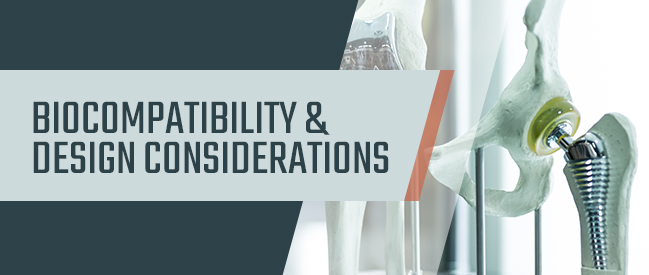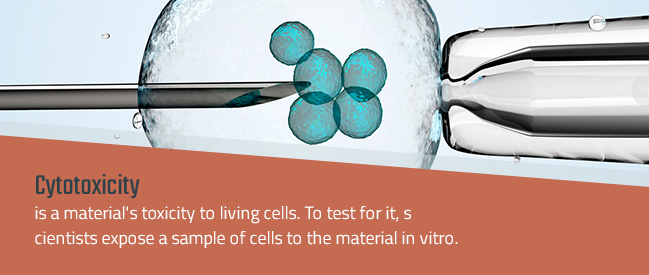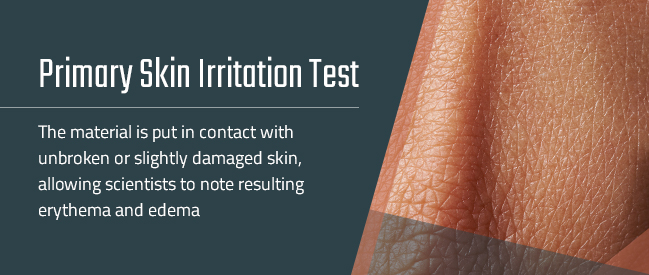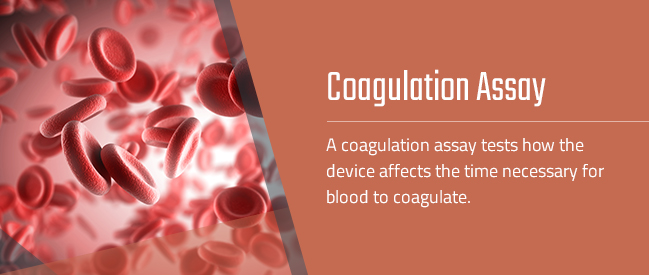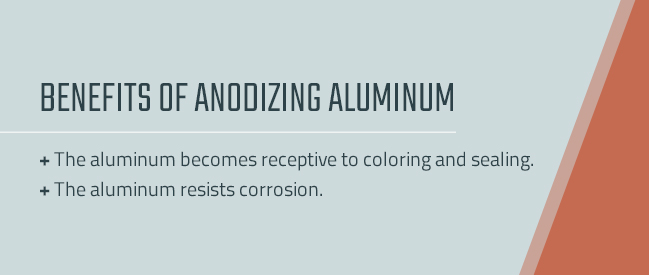What is biocompatibility? A biocompatible material is one that does not induce a response in living organisms, whether it be on their skin or tissue. Medically, such a material is useful because it is known to not cause allergic reactions, long-term problems or other complications in patients.
Biocompatibility is meant to eliminate undesired local, tumorigenic, systemic, developmental or reproductive effects. It is an absolute necessity in biomedical engineering, and it can often be accomplished by the process of plating. With plating, a product’s outermost surface is coated in a biocompatible substance that leaves it safe, easy to clean, aesthetically pleasing and with a host of other benefits. In terms of regulation, biocompatibility is verified by means of tests which gauge whether contact between a medical device and a patient’s body can lead to toxicity.
Electroplating, which provides a finish on metal products, is performed by immersing the component into a solution of dissolved nickel, gold, silver or other ions. When electrical current passes through the solution, these ions collect on the component, leaving it plated in the metal. This new coating has many advantages, which we will discuss in this article.
We’ll also dive into further detail on biocompatibility testing, data requirements and how medical devices are evaluated for safety and usability. Then we’ll take a look at anodized aluminum as a specific method for achieving biocompatibility. Finally, we’ll examine other forms of plating and how they affect biocompatibility. Let’s begin with the biocompatibility testing process.
Biocompatibility Testing
To qualify as biocompatible, parts must undergo a rigorous, multi-point series of tests. These include tests for the following:
1. Cytotoxicity
Cytotoxicity is a material’s toxicity to living cells. To test for it, scientists expose a sample of cells to the material in vitro. They perform different types of qualitative tests, after which they examine the cells for damage or malformation.
- Direct contact: This process involves setting the material directly on the cells, and is most useful for materials with a low density.
- Agar diffusion: This method is good for high-density materials, and involves placing the cells on top of a layer of agar supplemented with nutrients, which then sits on top of the material.
- MEM elution: This involves testing the materials and cells in realistic usage conditions.
Quantitative tests are preferable to qualitative tests, according to recent regulations. MTT is one of the most accurate and versatile of these tests. It uses a colorimetric method and is not at the mercy of different interpretations, making it an extremely valuable quantitative technique. Its limitations include its inability to specify a cause of cell death, as well as an occasional tendency to underestimate damage.
2. Sensitization Assays
These studies serve to identify whether chemicals within a material have undesired effects after long-term exposure. Immunologic defenses are responsible for causing allergic reactions, and the following tests are designed to identify chemicals that may trigger them.
- Guinea pig maximization test: This test applies to devices that will come into contact with a patient’s body or fluids. Scientists combine a solution called Complete Freund’s Adjuvant with the material to test for sensitivity.
- Closed patch test: If the device will only be contacting undamaged skin, this test evaluates its effects by applying several doses topically.
- Murine local lymph node assay: This test gauges the response of lymphocytes to the material to see if it acts as a sensitizer.
3. Irritation Tests
To see if the material induces local irritation, scientists test it on skin and mucous membranes. To ensure a safe user experience, the test conditions are often more stringent than likely real-life scenarios. The following are examples of this test.
- Intracutaneous tests: Scientists inject small doses of the material into the epidermis, then take notes on the response regarding redness or other allergic reactions. This test is recommended if the product will have internal contact or external communication.
- Primary skin irritation test: The material is put in contact with unbroken or slightly damaged skin, allowing scientists to note resulting erythema and edema.
- Mucous membrane irritation test: If the component will be in contact with unbroken mucous membranes, this test is useful to gauge the resulting safety. Small samples of the material are typically used.
4. Acute Systemic Toxicity
One danger biocompatibility tests seek to detect is the presence of leachable substances. In the acute systemic toxicity test, scientists inject mice with pieces of the material, then monitor them for any indications of toxicity. This test is important for materials that will come into contact with either blood or internal tissue. The material mediated pyrogen test is another variation that seeks to understand whether the material will cause fever if it comes into contact with the blood.
5. Subchronic Toxicity
The term subchronic refers to a timespan of moderate duration, and this test is intended to root out effects that can take place within a lifetime. To perform the test, scientists inject mice with several doses of the material and observe them for roughly 10 percent of their lifespan, or 90 days. These tests are useful for all materials that will contact internal tissues in patients.
6. Genotoxicity
Materials that can alter, damage or destroy DNA are a danger to patients and can cause cancer and genetic defects that can be passed on to offspring. The Ames Test is the most common test.It employs Salmonella typhimurium as a subject, since these bacteria are especially vulnerable to genetic mutation agents, and monitors to see if the material causes changes to occur. In vivo tests are often used supplementally.
7. Implantation Tests
When a device like a suture, pacemaker or clip is inserted into the body, doctors need to be certain the material itself will not cause harm. They do so with implantation tests, which screen both absorbable and non-absorbable materials with different methods to resemble real-life usage.
8. Hemocompatibility
Compatibility with the blood is essential for any device that is used intravenously, including catheters, blood transfusion materials and vascular prosthetics. The results of hemocompatibility are tempered by the fact that nearly every relevant device is, in some way, incompatible with blood by either leading to hemolysis or thrombogenicity. The following are examples of hemocompatibility tests.
- Homolysis assay: This test is useful for discerning how much damage a material causes red blood cells after exposure, comparing it to control groups for reference.
- Coagulation assay: A coagulation assay tests how the device affects the time necessary for blood to coagulate. Examples include the prothrombin time assay and the partial thromboplastin time assay.
- Complement activation test: This test displays the amount of complement activation in blood plasma after the material is introduced. It is recommended for implant devices that contact circulatory blood. This, in turn, predicts the risk of the material creating an inflammatory immune response due to the complement activation in humans.
9. Carcinogenesis Bioassay
Introducing foreign materials into or onto the body carries with it a certain risk of tumorigenesis. To test for this, scientists introduce the appropriate number of exposures over the lifetime of the test animal. Note that this test is the source of much controversy and can often be worked around.
10. Developmental and Reproductive Toxicity
For materials that are in steady contact with organs and tissues inside the body, a developmental and reproductive toxicity test is recommended to test for effects on reproduction, fertility and prenatal and postnatal development.
Biocompatibility of Anodized Aluminum
Anodizing biomedical equipment gives it a good chance of passing biocompatibility scrutiny. Aluminum is a material that naturally oxidizes to form a shiny, transparent coating that protects the interior profile from the atmosphere. This oxidation is desirable, but it occurs in a thin layer that operators seek to thicken through the process of anodizing.
The following are some of the benefits of anodizing aluminum:
- The aluminum becomes receptive to coloring and sealing. Anodized aluminum can accept stains and sealings, which mean it is both protected from damage and more versatile in its design.
- The aluminum resists corrosion. Tools naturally begin to wear down from repeated use — particularly when there is metal-on-metal contact or corrosive cleaning products. An anodized coating can resist this corrosion.
One interesting part of anodized aluminum is that the substrate is being oxidized by more aluminum, rather than by another metal such as gold. The aluminum substrate provides a bonding surface for aluminum oxide, which means the coating will not break or peel off. Additionally, the coating is porous and can accommodate further actions such as coloring.
To anodize aluminum, the component is placed in a bath of acid with an electrical current running through it. Because a cathode is attached to the wall of the bath, the aluminum naturally takes the role of an anode, which allows oxygen ions to break free and bond with the aluminum’s surface substrate. This method is nothing more than an artificially paced version of a natural process.
Anodized Aluminum Medical Devices
Anodized aluminum is a popular choice in manufacturing medical devices for several reasons:
- Aluminum is lightweight.
- Because of its structure, there is almost no limit to extrusion geometries that can be achieved with aluminum.
- It is easy to machine.
- Aluminum accepts many different types of colors, coatings and finishings.
- It is highly biocompatible.
- It does not require significant investment to tool.
- Aluminum is recyclable.
For these reasons, it is a common material for machined parts, stethoscopes and other medical devices. Aluminum’s malleability also makes it useful for tubing. Whereas steel tubes are too stiff to be bent by hand, surgeons can bend aluminum tubing easily and quickly by hand to the desired shape.
Plating and Biocompatibility
Plating uses the same basic method as anodization, but with the final result being a metal coating instead of an oxidized coating. Plating medical equipment has many benefits and leads to higher rates of biocompatibility. Chief among them are:
- Plated components are cleaner. Plating produces a smooth, uniform surface that is resistant to accumulating grime and is easy to wash. Additionally, metals like gold and silver have natural antimicrobial properties that make them inherently cleaner than other surfaces, which is a significant advantage in biomedical applications.
- They do not corrode as quickly. Surgical, implant and other such devices get handled and used with great frequency. This makes them especially vulnerable to breaking down. Aside from wearing out from friction, they can accumulate oils and oxidation wear that shortens their lifespans. Cleaning wipes often contain chlorine, which further degrades the material. Plating protects devices from everyday corrosive factors, thereby increasing the return on investment for users.
- They conduct heat and electricity more effectively. When a device needs to conduct electricity, lining it in metal guarantees the best contact and conductivity. Similarly, certain medical procedures benefit from material that operates as a heat sink, conducting heat away from the patient and reducing the risk of injury. Plating creates better conductivity, which increases this effect.
- Electroplating can make welds stronger. Welding metals together can lead to weak points, as certain metals are less receptive to welding than others. Electroplating can make the entire weld area sturdier. Welding different metals together is another application electroplating can make more reliable.
- Plating can strengthen catheters. Catheters used in medicine are braided, and coating these braids via electroplating strengthens the catheter immensely. It provides strength for joining the different sections together, as well as lowering the likelihood of kinks forming along its length.
- Plating can create a radiopaque area. When X-rays are administered to patients, the particles pass through most objects in the body. However, high-density metals like gold are substantial enough to block the transmission of particles. This creates a radiopaque area, which clinicians often desire in getting useful scans.
Patients are benefiting from plating as much as manufacturers these days. Improvements in technology are coupling with this practice to create new advancements, as less invasive procedures are opening the door to new surgical alternatives. This increase in biocompatibility has contributed directly to increases in patient comfort and recovery times.
Come to Sharrett’s Plating Company for Quality Plating
SPC is more than a plating company — we see plating as an end-to-end process that involves an expertise in surface treatments. We start by preparing the product’s surface for plating and end with coating or finishing. For the customer, this means a product that is reliable, durable and of the highest quality.
For example, we are able to plate materials like plastic and other nonconventional surfaces. Such materials allow for the creation of smaller, lighter products that are a staple of medical and dental industries. This not only opens the doors to more options for our customers, it also helps drive innovation — which is one of our greatest points of pride. This innovation has been responsible for our earning several patents throughout our career thus far, as with our invention of nickel-boron finishing.
As a family-owned company, we also take great pride in the excellence of our employees. For more than 90 years, we have relied on our incredible team to help us grow, innovate, develop and deliver products and techniques to the market. Among our ranks are some of the brightest chemical engineers, scientists and other professionals in the industry, and customers can sense the cumulative weight of their expertise when handling with our products.
Contact us today for a free quote and to take your manufacturing to the next level.


